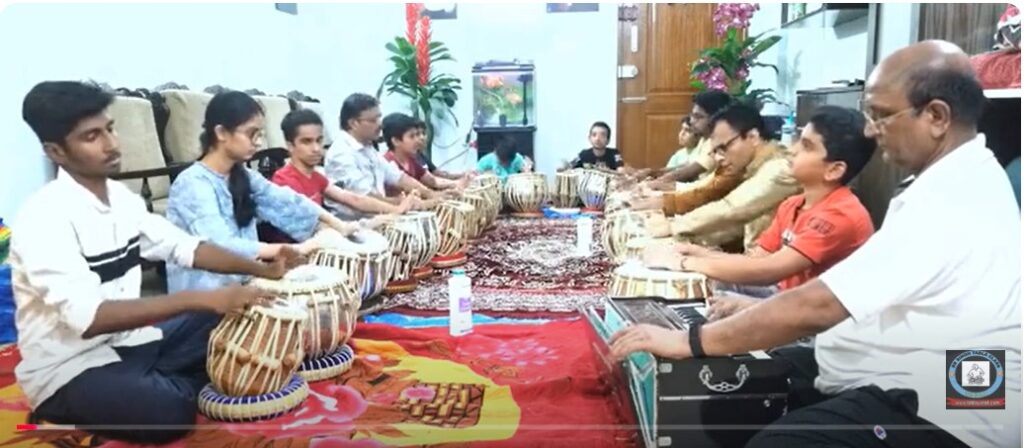Durgesh Taal Explored: The Art of Kayda in 9 Beats,
Introduction: The Rhythm Less Traveled
In the world of tabla, where rhythmic cycles (taals) like Teentaal (16 beats) and Jhaptaal (10 beats) dominate the stage, rare and lesser-known taals offer a thrilling sense of mystery and creativity. One such innovative rhythm cycle is Durgesh Taal, a 9-beat taal that breaks away from conventional frameworks. In this blog, we dive into the unique structure and artistic expression of a Kayda composed in Durgesh Taal, uncovering how it blends tradition with modern rhythmic innovation.
What is Durgesh Taal?
Durgesh Taal is not a classical taal found in traditional tabla textbooks; rather, it represents a contemporary or custom-composed taal, possibly named after a composer or thematic inspiration (such as the warrior goddess Durga). With 9 beats in its cycle, it opens up rhythmic possibilities that are less explored, yet full of creative potential.
While the taal may be new, its structure is rooted in the same principles that govern all classical Indian rhythm cycles—division, symmetry (or asymmetry), and internal phrasing.
Structure of Durgesh Taal (9-Matra Cycle)



A possible structure for Durgesh Taal could be as follows:
Theka (basic rhythmic pattern):Dha – Dhin – Na | Tin – Tin – Na | Dha – Tin – Na
(Divided as 3 + 3 + 3)
This 3-3-3 structure makes it symmetrical, but performers can experiment with 3-2-4, 5-4, or other divisions to create more tension and release in compositions.
What is a Kayda?
A Kayda is a structured improvisational composition in tabla. The word “kayda” literally means “rule” in Urdu/Hindi, referring to the foundational structure a tabla player must follow while improvising. Kaydas have:
- A fixed theme (mukhda)
- Vistaar (expansion) through paltas (variations)
- Return to the theme after each variation
The beauty of a kayda lies in creativity within discipline, much like jazz improvisation within a chord progression.
The Durgesh Taal Kayda: A Bold Exploration
Here’s a sample Kayda in Durgesh Taal (9-beat cycle) with a symmetrical structure:
Theme (Mukhda):
Dha – Tirkit – Tak | Tirkit – Tuna – Kit | Tak – Dha – Tun
Here, the use of Tirkit and Tuna Kit gives it a lively, bouncing texture, while the Tak Dha Tun at the end adds a conclusive punch.
Palta (Variation 1):
Dha – Tirkit – Tirkit | Tuna – Kit – Tak | Dha – Tirkit – Tun
Palta (Variation 2):
Dha – Tuna – Kit | Dha – Tirkit – Tak | Tirkit – Dha – Tun
Notice how each variation preserves the matra count (9 beats) while exploring different groupings and emphasis.
The final tihai (triplet phrase) to conclude the Kayda might look like:
Dha Tirkit Tak | Dha Tirkit Tak | Dha Tirkit Tak
(Repeated 3 times to land back on sam—the first beat)
Why 9 Beats? The Power of Odd Cycles
In Indian rhythm, odd matra taals like Matta Taal (9 beats) or Ardha Jhaptaal (9½ beats) challenge both the performer and the listener. Durgesh Taal, with its 9-beat cycle, adds to this family of complex taals that push the boundaries of rhythmic imagination.
Odd cycles don’t resolve as naturally as even-numbered cycles, which forces the artist to be more mindful of phrasing, intention, and space. This makes every Kayda in such taals a balancing act between logic and intuition.
Cultural & Contemporary Impact
While traditional taals dominate classical concerts, newer taals like Durgesh Taal are gaining popularity in experimental tabla solos, fusion music, and cross-cultural collaborations. Composers and performers are increasingly using custom taals to:
- Accompany new-age dance choreographies
- Score short films and theatre productions
- Compose tabla solos that break the mold
This Kayda in Durgesh Taal represents a bold rhythmic vision—a bridge between heritage and modern expression.
Listen & Learn
🎧 [Coming Soon: Audio Sample of Durgesh Taal Kayda]
(You can upload your own recording or visit YouTube channels like Pt. Suresh Talwalkar’s Rhythm Lab or Tabla Junction for similar compositions.)
Quiz Time: Can You Count It?
Question: How many divisions (vibhags) are there in a 9-beat Durgesh Taal divided as 3+3+3?
A) 2
B) 3
C) 4
D) 5
👉 Answer: B) 3
Poll: What’s Your Favorite Taal for Kayda?
- Teentaal (16)
- Jhaptaal (10)
- Ektaal (12)
- Durgesh Taal (9)
- Rupak (7)
👉 Vote in the comments and let us know!
Conclusion: The Future is in the Beats
As tabla continues to evolve, taals like Durgesh Taal prove that tradition isn’t static—it’s a living, breathing rhythm that adapts, innovates, and inspires. This 9-beat Kayda is not just an exercise in technique; it’s a statement of artistic courage.
🎬 So the next time you tap out a beat, try something different—try the nine.
Try Durgesh Taal.
https://www.youtube.com/@BhagawanSingh


